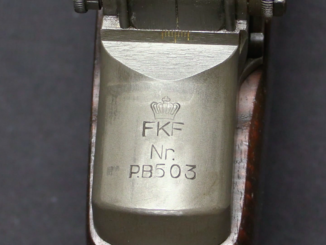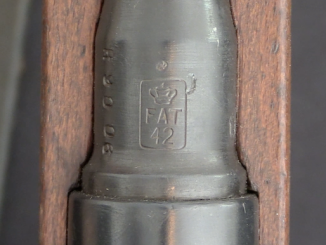This rifle started out its life an a normal M91 Carcano long rifle, before being converted into an experimental self-loader by the Terni Arsenal. Rather than adding a gas piston to the barrel, Terni engineered a short recoil system. The barrel and bolt recoil together about a centimeter (3/8 inch) upon firing. Instead of the original bolt with two lugs and a 90-degree throw, a new 8-lug bolt was used, which only requires a slight amount of rotation to unlock. That unlocking is done by an angled wedge that the bolt travels up as it recoils rearward.
The rifle is still chambered in the original 6.5x52mm caliber, using standard 6-round Mannlicher style clips. The date of the conversion is not clear, although the base rifle was manufactured in 1908.Thanks to Beretta for graciously allowing me to have a look at this rifle!




“Terni”
В.Е. Маркевич (Ручное огнестрельное оружие) describes Automatic rifle Terni Model 1921. It fired 6.5mm intermediate cartridge derived from 6.5mm service cartridge with overall mass 16g (instead of 24g), muzzle velocity 600m/s, sights scaled to 1000m, rifle has short barrel and overall mass is 3400g, can fire in single or full-auto mode, but in second accuracy is poor. It was trialled longly, but finally abandoned due to usage of non-standard cartridge.
Yet again it boils down to the fact that Italy could deal with this logistical hassle even less well than Germany. Remember that Hitler’s initial opposition to the idea of a machine carbine chambered in 8×33 Kurz was due to experience with the shortcomings of the Tiger and Panther tanks, which came from the lack of standardized parts and logistical support. Only if the rifle and ammunition performed well and could be supported by standardized tooling in the factories could any semiautomatic or select-fire rifle be adopted into service. Otherwise the army is wasting its resources!!!!
Are you referring to the fact that the Tiger and the Panther had no common parts? Because there was not much chance for either of them to have common parts with earlier German tanks, which were much lighter and smaller. If we compare them to other countries, the T-34 and Soviet heavy tanks (KV and later IS) did not have many common parts, either, apart from the guns of some models. The same applied to British Cruiser and Infantry tanks. The Americans didn’t use many heavy tanks due to the need to to ship tanks over the ocean, but once the M26 arrived, it didn’t have much in common with the M4.
I guess you got part of it. The lack of mass production of parts is the reason for failure. If there aren’t any spare parts then repairs are not likely to get done quickly. M4’s and T-34’s were produced in far greater numbers and the manufacturing support was better suited to transition from tractor or car production in their respective nations of origin… or am I wrong?
Cherndog,
sorry, but I do no quite agree with your interpretation.
When presented the then MKb42 her forbade continuing its development. But in the next sentence (of the protocol) he orders the development of a submachine gun that has an effective range of 200-300 m.
This had two effects:
The development of a new, more powerful cartridge for a submachine gun started. (Jim Stonley describes it in one of his articles in long gone Guns Review magazine.) In other words: wasting resources.
The other effect was renaming MKb42 to MP43 and using Hitler’s requirement for continuing the forbidden development under the false flag of a submachine gun.
This gun had been discussed elsewhere but is nowhere to be seen in real. I suspect it may not even exist.
Correction:
В.Е. Маркевич apparently made mistake, as in fact it used cartridge derived from 6.5 service cartridge, but firing 7.35 bullet, see photo here:
http://raigap.livejournal.com/314881.html
[photo: MOSCHETTO AUTOMATICO PER FANTERIA TIPO TERNI Mod. 1921.]
Special cartridge, intermediate, caliber 7,35x32mm, made from shortened case of 6,5×52 Carcano rifle cartridge. Round-nose bullet replaced with special Spitzer bullet, bullet mass 8,715g (134,5 grains) and has muzzle velocity 600 m/s. In early 1930s it was tested by Frankford Arsenal (USA) and it give very good impression. In inter-war Italy there were several experiments, including version for 7.35x51mm. “New” barrels were produced by boring-out older 6.5mm rifle barrels. Did not go into series production
[photo]
One of experimental models created during development of this weapon. Automatic rifle for rifle cartridge 6.5×52 Carcano. Principle: short-recoil. Notice small magazine for automatic rifle.
For the Terni mod.21, several cartridges had been tested. http://i1049.photobucket.com/albums/s390/mayatico/C.jpg
I wonder what was reason for such bullet diameter variation; it necessitated different barrels and relating tooling. Was it ballistic optimisation with sparse propellant load with less than 1/4 ratio?
As you can see the dates of the three first columns predates the test of the rifle. Infact the job of the Pyrotecnical laboratory was that to develop the “right” ammunition for the intended use, then the rifle had to be tailored around the ammunition chosen. Probably only the first cartridge (the 7.65 one) had been actually used in the 1921 trials of the rifle.
In the subsquent years, something must be changed, infact it was the fourth cartridge, the one developed in 1928, with an heavier ball and a shorter cartridge, that was tested by Frankford Arsenal in 1931. At least that means that the evolution of the project had not been completely halted.
couldn’t they put the recoil spring in the tube with the Vetterli end cap? Looks usable, and not improvised and clumsy like the Charlton rifle.
In all likelyhood, that’d the rifle that Maj. Luigi Gucci described in his book “Armi portatili” year 1915, p.58. http://www.talpo.it/files/64084385-armi-portatili-gucci-1915-i.pdf
Just another day, perusing the Beretta Reference Library. Zoinks.
This Terni rifle is real slick attempt with clear thinking behind it. Should they have brought it into fight in 1915, it would had been miserable news for my grandpaps (as it was miserable enough already).